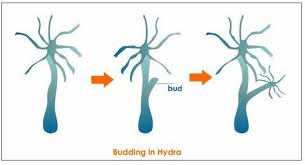Science Form 3 Chapter 4 And 5 (Revision)

- 1.
Name two types of reproduction?
- A.
Sexual and Sexualitism
- B.
Asexual and Seksyen
- C.
Sexual and Asexual
- D.
Sexualitism and Seksyen
Correct Answer
C. Sexual and AsexualExplanation
The correct answer is Sexual and Asexual. Reproduction can occur through sexual or asexual means. Sexual reproduction involves the fusion of gametes from two parents, resulting in offspring with a combination of genetic traits. Asexual reproduction, on the other hand, involves the production of offspring without the involvement of gametes or the fusion of genetic material.Rate this question:
-
- 2.
What the other type of asexual reproduction that same with figure above.
- A.
Binary fusion, regeneration
- B.
Vegetative, fertilisation
- C.
Amoeba, onion
- D.
Gametes, variation
Correct Answer
A. Binary fusion, regenerationExplanation
The given correct answer is "Binary fusion, regeneration." Binary fusion is a form of asexual reproduction where two organisms combine their genetic material to form a new organism. Regeneration is the ability of an organism to regrow lost or damaged body parts. Both binary fusion and regeneration are types of asexual reproduction, where offspring are produced without the involvement of gametes or fertilization.Rate this question:
-
- 3.
What is the function of scrotum?
- A.
Produces the male gametes.
- B.
A tube which runs through the penis.
- C.
Holds and protects the testes.
- D.
Neck of the uterus.
Correct Answer
C. Holds and protects the testes.Explanation
The scrotum is a pouch-like structure that holds and protects the testes. It helps to regulate the temperature of the testes, as sperm production requires a slightly lower temperature than the rest of the body. The scrotum contracts in cold temperatures to bring the testes closer to the body for warmth, and relaxes in warm temperatures to keep the testes cooler. Additionally, the scrotum acts as a protective layer for the testes, shielding them from potential injury.Rate this question:
-
- 4.
What is the name of the process of menstrual cycle during these day?
- A.
Menstruation phase
- B.
Repair phase
- C.
Premenstrual phase
- D.
Fertile phase
Correct Answer
C. Premenstrual phaseExplanation
The correct answer is the premenstrual phase. This phase occurs in the menstrual cycle a few days before menstruation begins. During this phase, the levels of estrogen and progesterone decrease, causing physical and emotional symptoms such as bloating, mood swings, and breast tenderness. It is a preparatory phase for menstruation and is characterized by changes in the uterine lining in anticipation of shedding during the menstrual phase.Rate this question:
-
- 5.
Name two types of pollination?
- A.
Self-pollination, behind-pollination
- B.
Self-pollination, cross-pollination
- C.
Self-pollination, besides-pollination
- D.
Self-pollination, above-pollination
Correct Answer
B. Self-pollination, cross-pollinationExplanation
Self-pollination refers to the transfer of pollen from the anther to the stigma of the same flower or within the same plant. Cross-pollination, on the other hand, involves the transfer of pollen from the anther of one flower to the stigma of another flower, often of a different plant. This can occur through various means such as wind, water, or pollinators like insects, birds, or bats. Both self-pollination and cross-pollination are important for plant reproduction and genetic diversity.Rate this question:
-
- 6.
What is growth?
- A.
Increase body size, number of cells, weight
- B.
Increase body shape, number of blood, weight
- C.
Increase body size, number of pimples, height
- D.
Increase body height, number of age, muscles
Correct Answer
A. Increase body size, number of cells, weightExplanation
Growth refers to the process of increasing body size, number of cells, and weight. It is a natural and essential part of development in living organisms. As an organism grows, its body size increases, which is accompanied by an increase in the number of cells and overall weight. This growth is regulated by various factors such as genetics, nutrition, and hormones.Rate this question:
-
- 7.
After the age 14, boys experience more __________ than girls.
- A.
Positive growth.
- B.
Rapid growth.
- C.
Slow growth.
- D.
Negative growth.
- E.
Minimal growth.
Correct Answer
B. Rapid growth.Explanation
During adolescence, boys tend to experience a growth spurt, characterized by a rapid increase in height and weight. This is due to the surge in hormones, particularly testosterone, which leads to the development of secondary sexual characteristics and overall physical growth. Girls also experience growth during this time, but it generally occurs at a slower pace compared to boys. Therefore, the correct answer is "Rapid growth" as it accurately reflects the typical growth pattern seen in boys after the age of 14.Rate this question:
-
Quiz Review Timeline +
Our quizzes are rigorously reviewed, monitored and continuously updated by our expert board to maintain accuracy, relevance, and timeliness.
-
Current Version
-
Mar 21, 2023Quiz Edited by
ProProfs Editorial Team -
Aug 17, 2010Quiz Created by
Ahaha
- Aeronautics Quizzes
- Aerospace Quizzes
- Agricultural Science Quizzes
- Astrology Quizzes
- Astronomy Quizzes
- Atom Quizzes
- Biochemistry Quizzes
- Biology Quizzes
- Biomechanics Quizzes
- Biostatistics Quizzes
- Biotechnology Quizzes
- Botany Quizzes
- Branches Of Science Quizzes
- Chemistry Quizzes
- Cytology Quizzes
- Easy Science Quizzes
- Ecology Quizzes
- Electrical Quizzes
- Embryology Quizzes
- Endocrinology Quizzes
- Engineering Quizzes
- Environmental Science Quizzes
- Epidemiology Quizzes
- Forestry Quizzes
- Fossil Quizzes
- Gas Quizzes
- General Science Quizzes
- Genetics Quizzes
- Histology Quizzes
- Human Biology Quizzes
- Integrated Science Quizzes
- Invention Quizzes
- Library Science Quizzes
- Lighting Quizzes
- Liquid Quizzes
- Marine Biology Quizzes
- Microbiology Quizzes
- Molecular Biology Quizzes
- Nature Quizzes
- Neuroscience Quizzes
- Nuclear Science Quizzes
- Oceanography Quizzes
- Physics Quizzes
- Psychology Quizzes
- Science And Technology Quizzes
- Science Glossary Quizzes
- Science Knowledge Quizzes
- Science Practice Quizzes
- Scientific Notation Quizzes
- Soil Science Quizzes
- Solar System Quizzes
- Solid Quizzes
- Zoology Quizzes
 Back to top
Back to top



